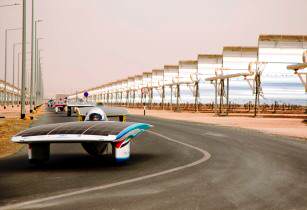Engineering university Petroleum Institute?s creation solar-powered car reached Shams 1 ? Abu Dhabi?s large-scale concentrated solar power plant located in Al Gharbiya ? on Sunday
The Petroleum Institute?s team is representing the UAE as part of the Abu Dhabi Solar Challenge (ADSC), the first International Solarcar Federation (ISF) sanctioned event in the Middle East.
Part of Abu Dhabi Sustainability Week (ADSW) and the first event of its kind in the region, the four-day solar car challenge from 16-19 January 2015 brought innovation to life and underscores Abu Dhabi?s role as a leader in the clean technology sector. Over the course of four days, the event saw over 20 of the top university solar car teams travel approximately 1,200 km.
The winners will be announced at Abu Dhabi National Exhibition Centre (ADNEC) during the opening ceremony of the World Future Energy Summit (WFES) 2015.
According to Masdar, its reputation as a renewable energy pioneer has helped bring the solar challenge to Abu Dhabi. The company?s mission to advance clean energy, along with Abu Dhabi?s role as an international energy hub, makes the emirate an ideal location for the competition, Masdar added.
An ADNOC spokesperson said, ?The UAE has been a pioneer in the region through its various renewable energy investments, both domestically and internationally, and it aspires to be an international hub for renewable energy and low-carbon technologies. Events such as the ADSC highlight that the UAE knows that to be a responsible oil producing nation, there needs to be a balance between hydrocarbons and renewable energy in the economy.?
One of the largest concentrated power plants in the world, Shams 1 powers more than 20,000 homes across the UAE and displaces 175,000 tonnes of CO2 per year. Inaugurated in March 2013, the plant covers a land area of 2.5 sq km and is made up of 768 parabolic trough collectors.





